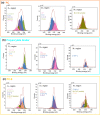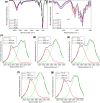Multifunctional cotton fabrics with novel antibacterial coatings based on chitosan nanocapsules and polyacrylate
- PMID: 37362951
- PMCID: PMC10088599
- DOI: 10.1007/s11998-023-00761-y
Multifunctional cotton fabrics with novel antibacterial coatings based on chitosan nanocapsules and polyacrylate
Abstract
Chitosan is a cationic polysaccharide with intrinsic antimicrobial properties that can be used as an ecological alternative to develop functional materials to inhibit the proliferation of microorganisms. This work evaluates chitosan nanocapsules (CNs) as a self-disinfecting agent to provide bactericidal activity on cotton fabrics (CF), using polyacrylate to bind the CNs on the CF surface. The fabrics were characterized by Fourier-transform infrared spectroscopy (FTIR), scanning electron microscopy (SEM), contact angle (CA), moisture retention, and antimicrobial tests against Escherichia coli and Bacillus subtilis. The FTIR results showed new peaks related to chitosan structure, indicating the adequate fixation of the CNs on the cotton fibers. SEM images corroborated the polyacrylate binder's efficient adhesion, connecting the CNs and the cotton fiber surface. The CF surface properties were considerably modified, while CN/polyacrylate coating promoted antibacterial activity against the B. subtilis (gram-positive bacteria) for the developed wipe, but they do not display bactericidal effects against E. coli (gram-negative bacteria).
Supplementary information: The online version contains supplementary material available at 10.1007/s11998-023-00761-y.
Keywords: Antimicrobial; Chitosan; Cotton; Multifunctional fabrics; Natural fibers.
© American Coatings Association 2023, Springer Nature or its licensor (e.g. a society or other partner) holds exclusive rights to this article under a publishing agreement with the author(s) or other rightsholder(s); author self-archiving of the accepted manuscript version of this article is solely governed by the terms of such publishing agreement and applicable law.
Figures







References
-
- Mohamed AL, El-Naggar ME, Hassabo AG. Preparation of Hybrid Nanoparticles to Enhance the Electrical Conductivity and Performance Properties of Cotton Fabrics. J. Mater. Res. Technol. 2021;12:542–554. doi: 10.1016/j.jmrt.2021.02.035. - DOI
LinkOut - more resources
Full Text Sources
